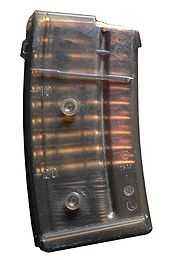Jungle style
The term "jungle style" refers to the practice of taping or securing two or more gun magazines together, with one taped upside down while the other is inserted into the rifle.
A jungle style configuration is used to speed up the process of reloading, since the other magazine is attached to the exhausted magazine, as opposed to being in a pouch, or other ammo storage unit. The downside to the configuration is that it can increase the weapon's chance of jamming, as one magazine and its ammunition are normally left exposed to dirt and the elements. Some firearms manufactures have designed their magazines with studs or cradles that allowed them to mate together without the need of tape or clamps, such as the Heckler & Koch G36[1] and SIG SG 550;[1] typically, these devices mount the magazines side-by-side and upright, so as to reduce the risk of ammunition falling out or becoming dirty.
History
The practice of "jungle style" magazines originated in World War II for the M1 Carbine, M3 "Grease Gun" and Thompson submachine gun.
Thompson submachine gun users frequently taped two 20 round magazines together to speed reloads and compensate for the limited capacity. This spurred official development of the 30 round Thompson magazine, which included the experiment of welding two 20 round magazines face-to-face (dropped in favor of the 30 round magazine). The 9mm United Defense M42 submachine gun was officially issued with two 20 round magazines welded face-to-face.[2]
Taping magazines together in order to speed up reloading became so common among troops using the M1 Carbine that the U.S. military introduced the "Holder, Magazine T3-A1", which came to be referred to by some infantrymen as the "Jungle Clip". This metal clamp holds two M1 Carbine 30-round magazines together without the need of tape.
References
- ↑ 1.0 1.1 Terry Gander, ed. (2006). Jane's Infantry Weapons 2006/2007. Jane's Information Group. pp. 179, 220. ISBN 0710627556.
- ↑ Eugene Liptak (2009). Office of Strategic Services 1942-45: The World War II Origins of the CIA. Osprey Publishing. ISBN 1846034639.
Image gallery
-
U.S. Navy SEAL in 1991 with MP5 SMG and two magazines clamped together.
-
A Polish soldier in June 1997, with MILES,gear, AKMS and three magazines taped together.
-

Detachable box magazine for a SIG 550 with studs for stacking multiple magazines together.
-

Sig SG 551 with three magazines held together.
-

Two Ruger 10/22 magazines attached.


